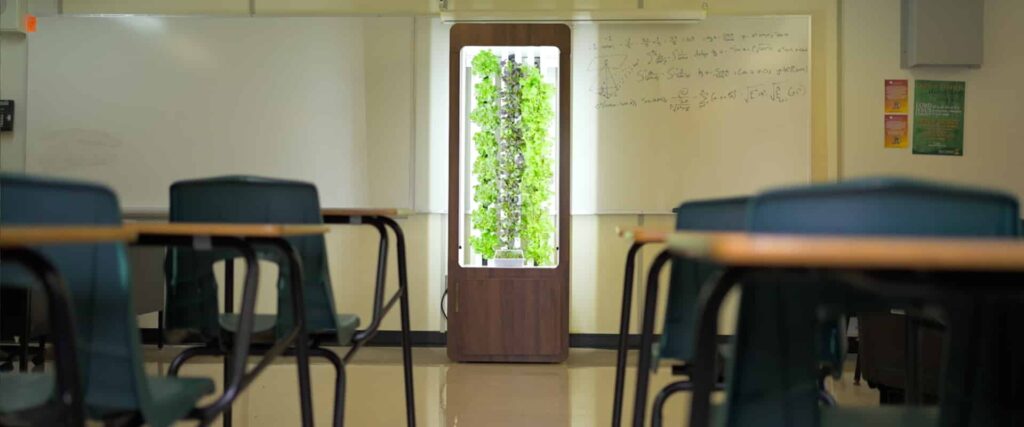Classroom gardening opens up unique opportunities for both teachers and students, from engaging new ways to teach STEM subjects to real-world connections with the community and future employers for students. While classroom gardens can transform the teaching-learning experience, obstacles like space, funding, and experience keep most educators from getting one. Solutions like compact or ZipGarden and alternative funding sources answer two of those needs; but what about experience? The same hurdle keeps even the most well-funded and space-endowed people from starting gardens.
What if a lack of experience was a help rather than a hindrance?
It would force the educator and the student to stop thinking in hypotheticals to solve problems, fix mistakes, and help others. We’ve seen this exciting new face of experiential learning surface in many classrooms, like those of Oliver Schinkten, Michael Paoli, and Kevin Savage. Each of these educators has had an interesting journey since beginning with their classroom gardens to the present time.
Today were going to take a look at Kevin Savage and a recent challenge that is giving him the opportunity to bring experiential learning into his classroom.
“Every experience provides me something of value if I look for it.
 Classroom Aquaponics in Cincinnati
Classroom Aquaponics in Cincinnati
Kevin Savage has been use classroom gardening at Cincinnati Hills Christian Academy for several years now. He knew from the beginning the value of experiential learning, which is why he runs his garden(s) with a bit of a twist.
Rather than growing in a classic soil garden, Kevin and another teacher, Gary, use aquaponics, a type of soil-less garden hooked up to a fish tank. This way, Kevin and Gary are able to use the fish and the construction of the indoor aquaponic gardens to teach not only plant science, but biology, engineering, and chemistry as well. Each of those subjects are taught experientially; his students build the systems, care for the systems, and troubleshoot the systems.
So what happens when something goes wrong?
Well, let’s see.
A few weeks ago, we saw a picture on of Kevin’s aquaponic system and noticed that the plants in a few of the ZipGrow towers were looking a bit wilted. We asked him if we could help him out to get his towers back on their feet.
In response to our check-in, Kevin explained that this photo was taken during the wall’s “off-season” when there was a bit of a mishap.
The photos [of the green wall] that you referenced [above] were from a post-school year teacher workshop hosted at CHCA with our friends from the Greenacres Foundation on Aquaponics for Educators

The Greenacres Foundation sponsored the workshop, which Kevin notes is a phenomenal local organization with a focus on education in many areas, including agriculture and the environmental disciplines.
He continues,
As luck would have it, in addition to the nutrient deficiencies obvious in the plants, we experienced restricted flow (due to a kinked main line) to several of the towers about 2-3 days before the workshop, resulting in pretty severe wilting of many of the plants.
Murphy’s Law anyone?” Problem” or “Learning opportunity”?
“The main line is rolled, semi-flexible irrigation tubing; the tubing is, however, somewhat rigid, which leads to kinking if not careful during installation. Water flow within the system worked well for 6-8 months, and we are not exactly sure how the kink developed, unless the tubing just sagged under its own weight (plus the weight of the water inside of the tubing).
You can see in the photo that the kink occurred immediately next to one of the push-in barbed fittings that supplies water to the individual tower. Perhaps the tower was kinked during installation of the barbed fitting, and gradually settled over time due to insufficient support. Perhaps the installation of the barbed fitting created a weak point in the tubing that later sagged under its own weight and kinked,” he speculated.
“You can also see the zip-tie that we added as a remedial measure to help restore flow to the towers ‘downstream’ of the kink. We will be replacing all of the mainline plumbing when the students return to school in August.”
The irrigation problem that Kevin faced with the system is one of the more common issues that people have to troubleshoot, as irrigation supplies vary greatly and flexible tubing can be finicky.
But for Kevin, the kinked line wasnt a disaster; it was just another opportunity to show his students a real-life problem.
This practical outlook on the aquaponic garden opened up an opportunity for Kevin to teach his students with an experience.
The highs and lows of classroom aquaponics
Returning to the discussion of the workshop, he went on to explain a rather important lesson;
“One of the items that we tried to emphasize with the workshop participants was that classroom aquaponics is not a casual activity, or a single ‘unit’ in a curriculum.
“It is a full-time endeavor, with amazing highs, and the occasional low (dead fish, flooded lab floor, desiccated plants, and nutrient deficiencies!).
These are some of those added complications associated with aquaponics. While hydroponic self-contained systems like the ZipGrow Spring System naturally don’t cause such problems, aquaponics system sometimes do, regardless of the growing technique. Aquaponics systems are prone to these types of issues because the solids (fish waste, fish feed, etc.) that cycle through the system are harder to manage than the nutrient solutions used in hydroponics.
Its these additional challenges that Gary Delanoy (fellow teacher) and Kevin find most compelling about aquaponics as a teaching tool. He says,
Gary and I are big believers in the experiential learning components that come with aquaponics, and addressing things like plumbing problems and nutrient deficiencies are an invaluable to the overall learning experience.
“While we love sharing the photos of thick, lush basil, lettuce, and kale, we are only telling a part of the story if we dont also share the challenges.
Going into further detail he explains,
One of our biggest challenges has been keeping the small diameter plumbing free from clogs of fish waste solids, fragments of uneaten or undigested fish food, and general organic goo resident in the system.
Using this challenge to teach the students about not only aquaponics, but also plumbing, engineering, and mechanics, Kevin, Gary, and the students have come up with a solution,
We are modifying this system to include either a swirl or radial flow solids separation unit, followed by a moving bed biofilter before we pump the nutrient-rich water to the towers. We are optimistic that this will alleviate (or at least significantly reduce) the clogging issues which were causing flow problems to some of the towers, he says. When everything if operating as it should, we are able to easily maintain about 8-9 gph flow to each of 12 towers.”
Taking advantage of the mishaps
While the system usually runs smoothly and grows lots of produce successfully, Kevin and Gary have learned to take advantage of the mishaps and craft their classroom experiences to create constructive lessons out of the challenges that arise.
The ZipGrow tower system has been the centerpiece of our aquaponics lab, largely because we have maximum growing area with minimum lab footprint. We have successfully grown a wide variety of herbs and greens, as well as strawberries. We began to see nutrient deficiencies in the spring, and are actually preparing a lab module for our curriculum for the students to identify and remedy deficiencies.
Providing some background into the systems aquaponics components and management he explains,
To date, we have not added any nutrient supplements to this system, and have relied solely on macro- and micronutrients from the fish feed / nitrification process.
Here are the most recent stats on the schools aquaponics system:
- Approximately 30 tilapia of mixed gender and species
Cincinnati Hills Christian Academy Aqauponics Green Wall
90-100 gallons of system water
- Fish vary in size from about 100 g to 150 g per fish, with a handful of outiers at the small and big end
- Total fish biomass is roughly 3 3.5 kg
- The fish are fed twice daily by automatic feeder with a commercial Ziegler feed
- The daily feed amount is 3-5% of total estimated biomass.
- The make-up water is calcium-rich (alkalinities typically between 75-100 ug/L, hardness usually >200 ug/L).
- The system pH is slightly above 7.
Now, as the school year approaches, Kevin is excited to get back to another year of providing students with new opportunities for experiential learning using aquaponics.
We are optimistic that we are moving towards having a dedicated aquaponics greenhouse in the next 12-18 months at school. When idea becomes reality, we will be investing in additional ZipGrow towers and expanding our teaching curriculum in the area of vertical farming!
“Thanks again for your email and interest; I value highly our working relationship with Bright Agrotech! Have a great evening and week! –Signed, Kevin Savage.
Kevin Savage and other educators are using ZipGrow Towers to give their students a memorable learning experience with practical, life-time skills. If you want to join them, try classroom aquaponics yourself. Shop for ZipGrow towers and start building your classroom aquaponics garden today.






